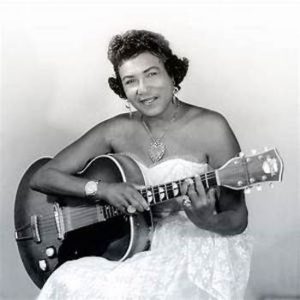
Memphis Minnie
Memphis Minnie was born on this date in 1897. She was a Black blues musician and singer.
She was born Lizzie Douglas in Algiers, LA. Before she turned ten, she and her family had relocated to Wall, Mississippi, just south of Memphis. As a child, she was known as Kid Douglas, and she learned to play the guitar and banjo. Sometime during her early teens, she began playing and singing on Memphis street corners and eventually joined the Ringling Brothers Circus, touring the South. During the 1920s, she settled into Memphis's Beale Street blues scene, where in 1929, a talent scout for Columbia Records discovered her.
Accompanied by guitarist Kansas Joe McCoy, her second husband (her first was the bluesman Casey Bill Weldon), she recorded later that year under the name Memphis Minnie. Her first song, “Bumble Bee,” was one of the most successful of the more than 100 songs she recorded before retiring in the mid-1950s.
Minnie and Kansas Joe migrated to Chicago in 1930, quickly becoming integral to the city's burgeoning blues scene. Along with Big Bill Broonzy, whom she reputedly beat in a "blues contest," and Tampa Red, Minnie helped the country blues style ease into an urban setting.
During the quarter-century she spent in Chicago, Minnie recorded for several labels and collaborated with various artists, most notably Sunnyland Slim and Little Walter. For some of her sessions, Minnie employed a small combo; for others, a second guitarist accompanied her. After her health began to fail in the mid-1950s, Minnie returned to Memphis and retired from performing and recording.
Many consider Memphis Minnie one of the best female blues singers ever. As a guitar player and blues singer, she ranks along with the blues' best female artists and the best male blues artists. She was among the first 20 performers elected to the Hall of Fame in the inaugural W. C. Handy Awards in 1980 (Garon, 1991). Memphis Minnie ranks with Ma Rainey, Bessie Smith, and Big Mama Thornton as one of the blues' most influential and historically significant female artists. Her roots were in country blues, an idiom dominated by men.
Minnie was also an excellent composer, an able guitarist, and an authoritative singer who packed her notes with a punch and rough-edged passion. Songs of hers, such as "Bumble Bee," "Hoodoo Lady," and "I Want Something for You," are genuine blues classics. Minnie's command of the blues was so great that her recording career spanned three decades and survived the numerous stylistic shifts within the blues.
Along the way, she influenced several prominent blues figures, such as Muddy Waters, and almost single-handedly kept a female presence in what became an increasingly male form. She spent her twilight years in a nursing home, where she died of a stroke on August 6, 1973.
Nothing But the Blues: The Music and the Musicians
Edited by Lawrence Cohn
Copyright 1993 Abbeville Publishing Group, New York
ISBN 1-55859-271-7